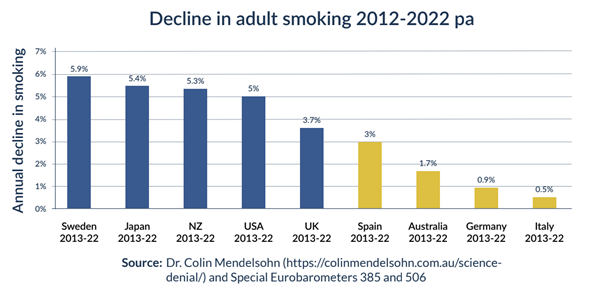Another World Tobacco Day, a date set by the World Health Organisation which aims to raise awareness about the global health risks associated with smoking, passes by with little changes in the state of the smoking epidemic in Europe. Both consumers and Members of the European Parliament are urging the European Union (EU) to take action and follow Sweden's successful smoking-cessation strategy. The EU has so far failed to implement an effective approach to combat smoking rates while Sweden, the only country in the world about to become smoke-free, is gaining huge attention for its remarkable achievements.
The EU, together with many other countries around the globe, is pursuing a counterproductive strategy to combat the smoking epidemic. Its approach has been that of making alternative products seem as harmful as tobacco, restricting access to them and increasing taxation to make them more expensive and discourage their use. And that strategy is yielding rather disappointing results.
Despite all the efforts made by the European institutions, the overall smoking rate in the EU still stands at 25%, and around 700,000 people die due to smoking-related illnesses every year. But rather than changing its approach, the EU plans to intensify its crackdown on alternative nicotine products, including higher taxation on vaping and flavour bans. Moreover, the idea of legalising snus remains absent, despite the fact that the only country exempt from the ban, Sweden, is the most successful in the fight against smoking thanks to the switch in smokers from tobacco to this less harmful alternative.
At the end of 2022, the daily smoking rate in Sweden was just 5.6%, by far the lowest in the EU, and the Scandinavian country is expected to reach the smoke-free target of below 5% at the end of the year.
Julia Kril, World Vapers Alliance
But why is the EU strategy failing? Because its restrictive approach to tobacco harm reduction products gives smokers only two options: total abstinence or smoking. While total abstinence may be the ideal goal for many, it is also highly unrealistic. The demand for nicotine consumption is evident, as millions of smokers worldwide demonstrate. Products like snus, vaping, and nicotine pouches effectively separate the most harmful components of smoking from nicotine consumption. Although not entirely risk-free, these alternatives offer a much less harmful way of consuming nicotine compared to smoking. Therefore, every smoker who switches to these products contributes to improving public health.
Sweden is on track to become the world's first smoke-free country, defined as having a smoking prevalence rate below 5%. At the end of 2022, the daily smoking rate in Sweden was just 5.6%, by far the lowest in the EU, and the Scandinavian country is expected to reach the smoke-free target of below 5% at the end of the year. Doing so will be a remarkable achievement since the EU’s target to become smoke-free is set to 2040, which would be 17 years later than Sweden.
But despite its success, the Swedish experience often goes unnoticed, both for the general public and for legislators. As Sweden reaches the smoke-free goal first, it is time for policymakers within the EU and worldwide to acknowledge their strategy.
A simple comparison between Sweden and other developed countries makes it evident that the Swedes have achieved a much more rapid reduction in smoking rates. The contrast becomes even starker when we compare Sweden with the countries that have implemented the most restrictive and illiberal policies regarding tobacco harm reduction products. For example, between 2012 and 2022, Sweden reduced its adult smoking rate more than twice as fast as Spain, six times faster than Germany, and nearly twelve times more quickly than Italy.

How did Sweden achieve such impressive results while other countries struggled? The answer lies in tobacco harm reduction. The availability and affordability of less harmful alternatives have played a crucial role in Sweden's rapid decline in smoking rates. To commemorate the Swedish success, the World Vapers' Alliance staged a protest outside the European Parliament featuring a giant cigarette symbolising Sweden's plummeting smoking prevalence.
Is the EU starting to recognise Sweden’s success? MEP Charlie Weimers recognised the Swedish harm reduction approach and stated that: “the World Health Organisation will soon classify Sweden as Europe’s first smoke-free country because of harm reduction policies and widespread use of snus.”; and MEP Nissinen urged the EU to follow its approach: “Sweden is the best example of how this is achievable, namely with a pragmatic harm reduction approach. Consuming snus instead of cigarettes saved many Swedish lives. It is time that the EU Commission expects this reality and starts acting accordingly.”
From a consumer standpoint, it is highly encouraging to witness an increasing number of politicians embracing harm reduction and fighting the attacks and misinformation on the most effective smoking cessation aids. Sweden leads the world in tobacco harm reduction, and the rest of the EU would do well to learn from its experience. With 700,000 annual deaths at stake, it is urgent to start heeding the advice of scientific experts, consumers, and public health professionals.
Sign up to The Parliament's weekly newsletter
Every Friday our editorial team goes behind the headlines to offer insight and analysis on the key stories driving the EU agenda. Subscribe for free here.